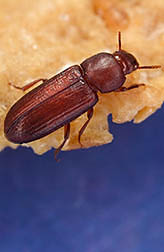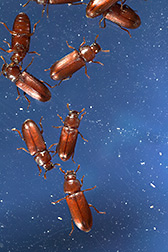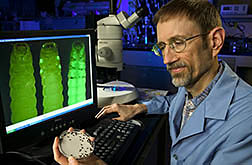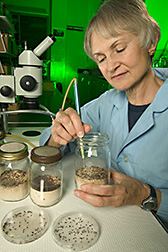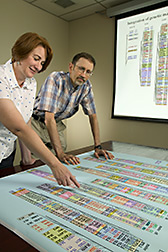Beetle Mania
With its genes recently deciphered, an
ordinary beetle goes from lowly pest to scientific star
A shiny, rust-colored beetle, only 1/8-inch long, scuttles across a kitchen countertop. It can’t resist the nearby stash of cupboard items for which members of its species have such an affinity—cornmeal, wheat flour, cake mix, crackers, and chocolate.
The pesky bug might seem nothing more than a nuisance to most. But to ARS entomologist Richard Beeman, this everyday pantry invader—the red flour beetle—has been the focus of more than 20 years of research.
Beeman, who works at the ARS Grain Marketing and Production Research Center in Manhattan, Kansas, has spent his career delving into the genes of Tribolium castaneum, hoping to unlock important secrets of this costly agricultural pest, its beetle cousins, insects as a group—and even ourselves.
Expensive Tastes
With their voracious appetite for stored cereals and nuts, the red flour beetle and its kin cause millions of dollars of damage annually. They can infest food products at any stage—from raw grain to finished baked goods. And when storage practices, like warehouse sanitation, fail to suppress soaring populations, insecticidal sprays and fumigants are often needed.
The resilient beetle has sidestepped most chemical control efforts—even developing thousandfold resistance to one common pesticide, malathion. But instead of developing new insecticides, which face strict regulation, Beeman envisions a more ecofriendly approach.
By finding the soft spots in the insect’s genetic armor, researchers may someday develop specific, genetically based ways of fending off the beetles. For instance, Beeman says wheat plants could someday be endowed with genes that disrupt the beetles’ normal functioning, were they to take a bite.
In Proper Sequence
Beeman isn’t the only researcher intrigued by the red flour beetle and its DNA. Two years ago, he and colleagues Susan Brown and Robin Denell at Kansas State University in Manhattan lobbied to have the beetle’s entire genetic makeup decoded.
As they saw it, the beetle would be the first agricultural pest—and beetle—to have its genome sequenced. Its genes might then inform researchers about other organisms—filling current gaps in the evolutionary biology of the fruit fly and honey bee genomes, for instance.
Plus, Tribolium stands out among insects as a generalist feeder that is very capable of surviving by feeding on a wide spectrum of foods. “It’s not specialized like the fruit fly, which feeds narrowly on rotting fruit,” says Beeman, “or the honey bee, which feeds exclusively on pollen and nectar.”
The beetle’s diet is actually more like our own. Before humans began stockpiling grains on farms, inside warehouses, and in cargo ships, beetles were probably exploiting rich caches of grains and nuts inside mouse nests, Beeman thinks. “They may have been feeding on stored grains and nuts even before we were.”
The beetle’s also unusual in its ability to live in arid environments, possessing well-developed kidneylike organs to facilitate water retention. “As comparative knowledge of animal genomes progresses,” Beeman says, “it’s become increasingly clear that insects and humans share many common genes involved in metabolism, development, and immunity to infection.”
|
|
Beetlejuice
In 2003, the red flour beetle was officially added to the growing queue of to-be-sequenced organisms. Before the project could begin, researchers needed starting material: copious amounts of the beetle’s DNA. But from where?
Crushed-up beetle eggs, of course. Beeman was the likely candidate for supplying this vital component, since his lab was already home to thousands of beetles. Some possess a variety of genetic kinks, or mutations, that he’s studying to learn more about the true functions of Tribolium genes.
Starting with a healthy red flour beetle from a corn bin in Georgia and subjecting it to 2 years of intensive breeding, Beeman and colleagues produced an army of identical beetle twins. About 100,000 of them were enlisted to turn out some 2 million eggs—about 50 grams worth. “It was a highly inbred strain,” says Beeman. “To simplify interpretation of the genome sequence, we didn’t want much variability across the beetle’s individual genes.” The eggs were frozen in liquid nitrogen and sent to Baylor College of Medicine’s Human Genome Sequencing Center (HGSC), where their DNA was extracted and sequenced.
The first version of the genome sequence was released in January 2005 by HGSC. The final version will be released soon, and Beeman says the information it yields should prove to be a gold mine. With the sequencing data as their guide, he and ARS molecular biologist Marce Lorenzen and colleagues hope to identify all of the beetle’s 15,000 genes.
|
|
Too Thin-Skinned?
Beeman has already tapped the unraveling genome to obtain basic information about how Tribolium and other insects produce the stiff outer coat, or cuticle, that’s the hallmark of most invertebrates.
“Because the cuticle isn’t elastic,” he says, “insects get squeezed as they grow. Eventually they shed it and secrete another that’s a bit larger—like getting a loose-fitting suit with growing room.”
For several years, scientists have been trying to pinpoint genes that regulate the complex process by which insects develop—and shed—these outer shells, which are made of a substance called chitin. By “knocking out,” or inactivating, candidate genes that genomic data had pointed to, Beeman and colleagues were able to isolate those responsible for orchestrating the chitin-production process.
“We got dramatic results,” he says. “When we knocked out Tribolium genes that encode enzymes suspected to be important for cuticle tanning [hardening and darkening], the cuticle in those beetles just stayed white and soft.” Without the genetic messages needed to tell their bodies to produce the right enzymes, the beetles simply died.
|
|
“Studies such as these will lead to better understanding of insect growth and development,” says Beeman, “and provide better approaches for disrupting specific genes as a form of nonchemical insect pest control.”
Beeman will continue to probe the beetle’s DNA for more answers. A gene holding his interest for more than 13 years is one he discovered in the female that mysteriously causes some of her hatchlings to abruptly die, while having no effect on her. But offspring inheriting a copy of the gene survive.
Considered a maternally acting, “selfish” gene, it’s called the Medea factor—named after the enchantress in Greek mythology who murders her own children for personal gain. Since Beeman’s find, a similar gene has only been found in mice. “Medea’s fascinating and unique,” he says. “I want to learn more about its evolutionary origins and physiological mechanism.”
As interpretation of the Tribolium genome continues, we’ll likely learn more about that curious gene—and how we may share much more with the modest red flour beetle than just our appetite for grains.—By Erin K. Peabody, Agricultural Research Service Information Staff.
This research is part of Plant, Microbial, and Insect Genetic Resources, Genomics, and Genetic Improvement, an ARS National Program (#301) described on the World Wide Web at www.nps.ars.usda.gov.
Richard Beeman is with the USDA-ARS Grain Marketing and Production Research Center, 1515 College Ave., Manhattan, KS 66502; phone (785) 776-2710, fax (785) 537-5584.
"Beetle Mania" was published in the November 2005 issue of Agricultural Research magazine.







